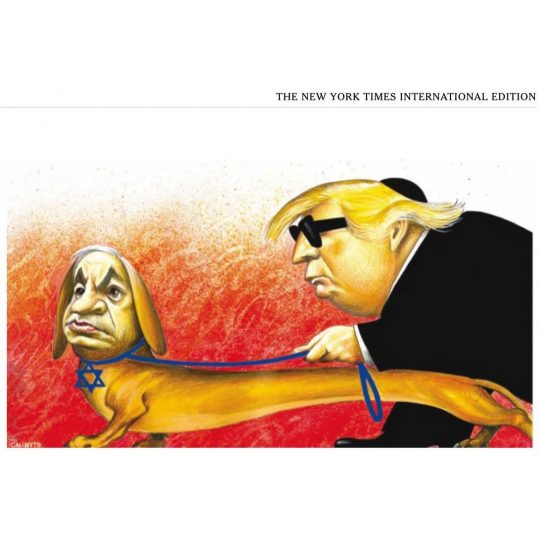It somehow took the New York Times two tries to apologize for their decision to publish an anti-Semitic cartoon in the international edition this weekend. The cartoon in question featured Israeli Prime Minister Benjamin Netanyahu as a dog with a Star of David, leading around President Donald Trump. Critics noted that the cartoon rather clearly played on age-old stereotypes of Jews as beasts controlling the U.S. government.
2. Here’s the anti-Semitic cartoon that the NYT published pic.twitter.com/ucLCLIyTgJ
— Yashar Ali 🐘 (@yashar) April 27, 2019
But second to the offense to the Jewish people is the offense to comedic sensibilities. The joke here is that Netanyahu sucks, and Trump is stupid, and ... that's basically it. Trump is depicted in a yarmulke for no real reason at all (although the Times desperately called it a "skullcap"). It's just a bad joke, and offers nothing new or unique in the way of political commentary that you can't get from skimming the Protocols.
Amazingly, the Times somehow managed to publish this cartoon only days after apologizing for the first anti-Semitic cartoon.
So the @nytimes removed the original anti-Semitic cartoon and replaced it with a different (anti-semitic) cartoon two days later. pic.twitter.com/bBihm5VCej
— The Reagan Battalion (@ReaganBattalion) April 29, 2019
Again, I don't even know what point is supposed to be here. Bibi is depicted as Moses, he's holding the Ten Commandments repurposed as the Star of David, and also a selfie stick, and this means... what exactly? I want to dig deeper and opine on the anti-Semitic nature of the cartoon's argument, but I can't even discern the actual argument.
These ran in the New York Times. And they're awful! Not simply for the anti-Semitism; they're just really bad cartoons on the merits. Is this really the best our nation's newspaper of record can offer up?
It's not entirely the Times' fault. Political cartoons are limited by their nature to dumbed-down, unsubtle commentary. Complicated human beings are reduced to literal caricature. The only way to escape the constraints of the medium is to engage in the behavior so wonderfully mocked by the Onion's parody cartoonist Stan Kelly; excessive over-labeling, walls of text, or an insipid author avatar sitting in the bottom righthand corner explaining the joke.
Not since the days of Tammany Hall has a political cartoon drawn attention to an issue of public importance, genuinely affected change, or changed a single mind. Today's political cartoons are hysterical and nasty nonsense tailored to be spread on Facebook groups called "Occupy Democrats" and "Drumpf Watch." I have been deluged with political cartoons in newspapers and social media for the past five years, and I have never, ever found one enjoyable. These days they're basically Internet bumper stickers and come with the same level of insight and wit.
I suppose the rejoinder to my complaints about the nastiness and lack of good commentary in political cartoons is that these are cartoons, meant first and foremost to amuse, not inform. But most political cartoons aren't particularly funny either. Peruse "the best" of WaPo political cartoonist Tom Toles' 2018 cartoons and count the number of times you laugh. I'll save you some time; the answer is going to be none.
Modern political cartoons have gone the way of late night television and Comedy Central, searching for "clapter" from members of the in-group instead of genuine chuckles. As Slate's Matthew Dessum first recognized, even the anti-Trump covers of The New Yorker (effectively a full-page cartoon) have gotten "thirsty": "These covers don’t say anything interesting or meaningful about our current moment in history, they’re rarely pointed, they’re rarely funny, and they’re rarely surprising. Whatever they’re ostensibly about, they all repeat the same message: "RETWEET IF YOU AGREE."
The other defense is that cartoons are works of art and shouldn't be judged simply on their editorial content, you cretin. Some art; Politico cartoonist and Pulitzer Prize-winner Matt Weurker has to go out of his way to label the various Republicans he's skewering because he's incapable of drawing them in an identifiable way. As Andy Ferguson once noted, even the much beloved Herblock who drew for WaPo for decades "had only the most rudimentary talent for drawing. You’d think this would be a deal-killer for a cartoonist hoping to make a living, much less rise to the top of his trade."
What ended up propelling Herblock to fame, Ferguson argued, wasn't his talent, but his kneejerk liberal commentary. For all the talk of factionalism and media bubbles, it has escaped the notice of most media observers that political cartoons are the single most partisan-divided medium out there. Your local paper's cartoonist is either a diehard liberal Democrat or an enthusiastic Trump supporter. Gone are the days of the late, great Jeff MacNelly, a Republican in sensibilities, but one who would skewer GOP politicians in a heartbeat if it made for a funny gag. The modern political cartoonist is an unabashed propagandist and nothing more.
Dozens of newspapers across the country that purport to support enlightened debate also run nasty, partisan, hackish, unfunny, untalented drivel in deference to an artform that is all but dead. Unsurprisingly, the result is occasionally they end up okaying nasty, partisan, hackish, unfunny, untalented, bigoted drivel. Why should the Times be surprised that their cartoons ended up spreading hate? That's all they're good for these days.
